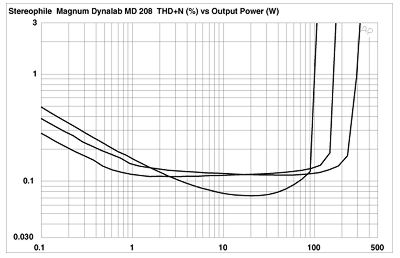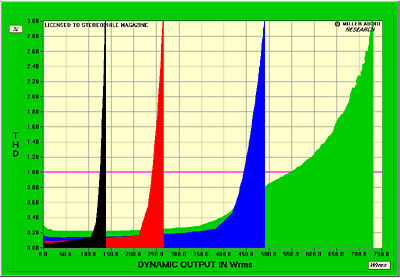| Columns Retired Columns & Blogs |
Magnum Dynalab MD 208 receiver Measurements part 3
With both channels driven continuously, the MD 208 met its specified power rating into 8 and 4 ohm loads at the usual 1% THD+noise level (fig.8). Almost 300W were available into 2 ohms. With one channel driven, and with a low-duty-cycle 1kHz toneburst (10 cycles on, 400 cycles off), a signal that better mimics music, the MD 208 delivered more than its specified power, as can be seen in fig.9. Again at a 1% THD level, the receiver delivered 125W into 8 ohms (21dBW, black trace), 241.6W into 4 ohms (red, 20.8dBW), and 447W into 2 ohms (blue, 20.5dBW). Only into 1 ohm (green trace) did the output power begin to be accompanied by a significant increase in distortion. Even so, 553W (18.4dBW) were available at 1% THD.

Fig.8 Magnum Dynalab MD 208, distortion (%) vs continuous output power into (from bottom to top at 10W): 8 ohms, 4 ohms, and 2 ohms (both channels driven).

Fig.9 Magnum Dynalab MD 208, distortion (%) vs 1kHz burst output power into 8 ohms (black trace), 4 ohms (red), 2 ohms (blue), and 1 ohm (green).
Although I would have liked to have seen lower THD at high frequencies, in all, this is a respectable set of measurements that reveals a sensibly solid design.—John Atkinson
- Log in or register to post comments




































